CPP GENERAL PURPOSE
BRAKE TROUBLESHOOTING GUIDE
© 2003 Classic Performance Products, Inc.
No copies or reproductions in all or in part of this document may be made
without written consent of CPP
except in the express use for installing or troubleshooting CPP supplied
product.
All Rights Reserved.
Read these instructions carefully and completely before installing
your kit! Here are a few basic to help ensure a
safe brake system:
- Use only new brake fluid. Contaminated fluid can
cause damage to the sensitive hydraulic brake components during the bleeding
process, corrodes components and increases likelihood of system failure.
Even unused fluid that was opened at an earlier time should not be used.
Brake fluid is hygroscopic meaning that it absorbs moisture from the air.
This moisture degrades the properties of the brake fluid.
- Cleanliness is very important. Make sure you clean the
fittings and surrounding area before opening any part of the brake system
to keep contaminants from entering the fluid.
- Power brake upgrades, be sure to check for a minimum
of 18 in. of vacuum prior to performing the upgrade. Vehicles with
tall heads or superchargers most likely will not have sufficient vacuum.
If you do not have sufficient vacuum, check your intake manifold for clogging,
vacuum fittings and for collapsed vacuum lines. Also ask us about our 12
volt vacuum pump.
- Never eliminate loops from vacuum lines as these act
as moisture and vapor traps. Check the vacuum lines for gas odor or the
presence of moisture. Gas fumes can deteriorate the internal rubber components
of the booster.
- Do not use petroleum-based solvents to clean brake components.
Use only cleaning fluids specifically designed for brakes since they leave
no residue when they dry.
- Do not use compressed air to dry brake components, even
filtered air may contain moisture or traces of oil.
- Check brake lines for cracked, leaking or swollen lines,
these must be replaced.
- Do not move or drive the vehicle until a firm pedal is
established.
Not Enough Brake
(See Spongy, Low or No Pedal or Rock
Hard Pedal) |
•Brake Fade
•See Overheating or Dragging Brakes |
•See Brake Fade |
| •Vehicle too heavy for brake system (drum brakes, added
larger engine, etc.) |
•See Why change to Disc Brakes
•Test booster, See Test Power Brake Booster
•Test master cylinder, See Test Master Cylinder
•Install booster or increase booster size
•Increase rotor size |
| Spongy, Low or No Pedal |
•Air in lines |
•Bleed Brake System See Troubleshooting
Bleeding Difficulties and Bleeding
Guide
•Use Speed Bleeders to facilitate bleeding. |
| •Aerated brake fluid |
•Completely flush and replace brake fluid
•Check for overheating conditions See Overheating
or Dragging Brakes |
| •Parking brake out of adjustment |
•See Rear Disc Brake and Parking Brake
Adjustment |
| •Unequal pressure between front and rear lines |
•See Test Combination/Proportioning
Valve |
| •Incorrect pedal ratio |
•See Check Pedal Assembly |
| •Bad flexible brake hoses |
•See Check Flexible Brake Hoses |
| •Booster pushrod out of adjustment |
•See Check Booster Pushrod Adjustment |
| •Caliper misaligned to rotor because of bent caliper
bracket or loose wheel bearings |
•Check caliper bracket alignment
•Replace wheel bearings |
| •Hard lines bent above master cylinder fluid level |
•Replumb hard line to remain below master cylinder fluid
level |
| •Master cylinder bore size too small for application |
•Small bore master cylinder requires longer pedal travel
to apply brakes
•Replace with larger bore master cylinder |
| •Bad power booster |
•See Test Power Brake Booster |
| •Air in master cylinder |
•Bench bleed the master cylinder See Bleeding
Guide |
| •Bad master cylinder |
•See Test Master Cylinder |
| •Bad or leaky Caliper |
•Replace caliper |
| •Master cylinder located below calipers or lines w/ no
residual check valve |
•See The Right Valves |
| •Drum Brakes: No residual check valves |
•See The Right Valves |
| •Drum Brakes: Upgraded larger drums |
•See Why change to Disc Brakes
•Install booster or increase booster size |
| •Drum Brakes: Overarched shoes |
•Replace drum, it may have been turned too many times
causing not enough contact between shoes and drum |
| •Drum Brakes: Oversized Wheel Cylinder for master cylinder |
•Replace with larger bore master cylinder |
| Rock Hard Pedal |
•Insufficient Vacuum |
•Check vacuum pressure See Test
Power Brake Booster |
| •Blocked Vacuum Check Valve |
•See Test Power Brake Booster |
| •Bad power booster |
•See Test Power Brake Booster |
| •Frozen Wheel Cylinder |
•Replace caliper |
| •Binding Pedal linkage |
•Inspect pedal assembly |
| Overheating or Dragging Brakes |
•Improperly adjusted parking brake |
•See Rear Disc Brake and Parking Brake
Adjustment |
| •Pre-loaded master cylinder or power booster |
•See Check Pedal Assembly
•See Check Booster Pushrod Adjustment |
| •Bad power booster |
•See Test Power Brake Booster |
| •Drum Brakes: Residual check valves |
•Remove residual check valve See The
Right Valves |
| •Frozen parking brake cable |
•Replace parking brake cable |
| •Bad Calipers or wheel cylinders |
•Replace caliper |
| •Overfilled master cylinder |
•Fill to correct level for master cylinder, typically
1" from lip |
| •Drum Brakes: Drums out of adjustment |
•Drums may be adjusted too tight, readjust |
| Brake Light on Dash is on |
•Air in lines |
•Bleed Brake System See Troubleshooting
Bleeding Difficulties and Bleeding
Guide
•Use Speed Bleeders to facilitate bleeding. |
| •Unequal pressure between front and rear lines |
•See Test Combination/Proportioning
Valve |
| Underbraking - Car pulls to one side or one wheel locks up |
•Oil or fluid on brake pad |
•Clean or Replace pads and check for damaged or leaky
lines or calipers. |
| Pedal too low or excessive
pedal freeplay |
•Incorrect pedal ratio |
•See Check Pedal Assembly |
| •Too much space between booster pushrod and master cylinder
pushrod |
•See Check Booster Pushrod Adjustment |
| Parking Brake not working |
•Parking Brake out of adjustment |
•See Rear Disc Brake and Parking Brake
Adjustment |
| Poor Panic Braking |
•Air in lines |
•Bleed Brake System See Troubleshooting
Bleeding Difficulties and Bleeding
Guide
•Use Speed Bleeders to facilitate bleeding. |
•Brake Fade
•See Overheating or Dragging Brakes |
•See Brake Fade |
| •Vehicle too heavy for brake system (drum brakes, added
larger engine, etc.) |
•See Why change to Disc Brakes
•Test booster, See Test Power Brake Booster
•Test master cylinder, See Test Master Cylinder
•Install booster or increase booster size
•Increase rotor size |
| •Insufficient Vacuum |
•Check vacuum pressure See Test
Power Brake Booster |
| •Blocked Vacuum Check Valve |
•See Test Power Brake Booster |
| •Bad power booster |
•See Test Power Brake Booster |
| •Drum Brakes: Upgraded larger drums |
•See Why change to Disc Brakes
•Install booster or increase booster size |
| •Drum Brakes: No residual check valves |
•See The Right Valves |
| •Drum Brakes: Overarched shoes |
•Replace drum, it may have been turned too many times
causing not enough contact between shoes and drum |
| •Drum Brakes: Oversized Wheel Cylinder for master cylinder |
•Replace with larger bore master cylinder |
Troubleshooting Bleeding Difficulties
If you are having difficulty getting all the air out of
the system or you are not obtaining a firm pedal, try these steps to assist
in the bleeding process and track down problem areas on the vehicle. A
spongy pedal is usually caused by air in the system.
- While bleeding, raise the end of the vehicle that is
being bled, this may help air trapped in the system to rise towards the
bleeder screw.
- While bleeding, lightly tap the caliper with a hammer.
This can dislodge air bubbles that cling to the walls of the caliper reservoir.
- Check for damaged brake hoses that may be internally
expanding from the line pressure. (See Check Flexible
Brake Hoses)
- Use line locks (vice-grips) to restrict fluid flow in
the rubber lines at each wheel between the frame and the axle to help pinpoint
the trouble spot. Lock all four wheels at the same time. Be aware that
crushing the brake lines can damage them. To help prevent this, wrap the
jaws of the line locks with a shop towel and close the line locks just
enough to restrict the flow of fluid. DO NOT OVER TIGHTEN
- With the lines to all four wheels blocked off, check
the pedal. You are looking for a firm hard pedal that does not drop under
constant pressure over a short period of time. If you get a hard pedal,
then the problem is definitely at one of the wheels. If the pedal is still
spongy, first make sure the lines are effectively restricted and try the
pedal again. If you still do not have a firm pedal, then remove the master
cylinder to follow the bench bleed and test procedure.
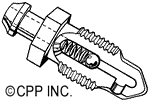 If you do have a hard pedal, then remove the
line locks from the farthest wheel from the master cylinder and press the
pedal. If the pedal is spongy again, the wheel you just released is the
problem wheel and requires further bleeding. (In rear disc brakes, the
problem may also be that the parking brake needs adjustment. Check your
parking brake adjustment before proceeding.) Check to make sure that all
the steps for bleeding are followed. If you are still having difficulty,
we suggest the use of Speed Bleeders to help ensure air does not return
in the lines when the pedal is released. Otherwise a power bleeding system
may need to be employed or a professional brake specialist. If you do have a hard pedal, then remove the
line locks from the farthest wheel from the master cylinder and press the
pedal. If the pedal is spongy again, the wheel you just released is the
problem wheel and requires further bleeding. (In rear disc brakes, the
problem may also be that the parking brake needs adjustment. Check your
parking brake adjustment before proceeding.) Check to make sure that all
the steps for bleeding are followed. If you are still having difficulty,
we suggest the use of Speed Bleeders to help ensure air does not return
in the lines when the pedal is released. Otherwise a power bleeding system
may need to be employed or a professional brake specialist.
- If the pedal is still firm then continue on to the next
wheel in the proper bleeding order, which is the wheel with the next longest
line in the system, release the line lock at that wheel and test the pedal
again. Note that it is normal to have a small amount of increase in travel
as you release the line locks from each brake hose.
Back to Top
The Right Valves
Using the correct valving for your application is critical
to the proper operation of your brake system. There are four types of valves
that perform different functions to the brake system.
| . |
|
 |
•Metering Valves
These valves are used to equalize braking action of a Disc/Drum brake system
by preventing the disc brakes from applying until about 75 - 135 psi has
built up in the lines. This delays the disc brakes and allows the drums
to catch up. This provides rear stability on wet surfaces and reduces front
pad wear. Metering valves are generally located in the lines to the disc
brakes. In most of our kits, the metering valve is a part of the combination/prop
valve. |
 |
•Proportioning Valves
The function of the proportioning valve is to limit pressure to the rear
brakes relative to pedal force, especially when high pressure is required
to apply the front disc. This prevents the rear wheels from locking up
as weight is shifted forward during braking. Proportioning Valves are generally
located in the brake line to the rear brakes and sometimes are incorporated
into the master cylinder. They are available as either preset or adjustable
valves. Note that adjustable proportioning valves are not DOT approved
for street driving and should only be used for racing applications! |
 |
•Residual Check Valves
These valves are used to hold a certain amount of pressure in the lines
even when the pedal is not pressed. This is a sort of preload line pressure
to activate the brakes more quickly. They will give a higher, harder and
more responsive pedal. Residual check valves should not be used as a
substitute for a properly functioning system. For instance, do not
use residual check valves in place of complete and proper bleeding procedures
as presented in this guide and our Brake
Bleeding Guide. Check valves will most likely be necessary when the
master cylinder is lower than the calipers or hard lines run higher than
the master cylinder fluid level. In disc brakes a 2 lb. residual check
valve prevents fluid from flowing back without causing the brakes to drag.
With drum brakes, a 10 lb. valve is used to compensate for return spring
tension in the drums. Residual Pressure Valves are generally color coded
blue for 2 lb. and red for 10 lb. for easy identification. |
 |
•Combination Valves
These valves offer multiple functionality in a single unit. They combine
the functions of both a metering valve and a proportioning valve with the
addition of a brake light warning switch. The brake light warning switch
signals when there is an imbalance of pressure in the system caused by
a problem in the front or rear brakes. By far the best valve to use for
all disc brake conversions. All our kits use DOT approved Combination Valves
designed specifically for either Disc/Disc or Disc/Drum applications. |
| |
|
Check Booster Pushrod Adjustment
The pushrod that actuates the master cylinder must be
properly adjusted. Ideally there should be only slight clearance between
the booster pushrod and the master cylinder pushrod. Interference will
preload the master cylinder. When the system is preloaded, it builds pressure
each time the pedal is pressed. Since the master cylinder is not allowed
to fully release the pressure from the previous stroke, the system will
eventually lock the wheels. Too much clearance will cause excessive freeplay
in the pedal. In almost every case, if you bought your booster and master
cylinder from us, we pre-adjust the booster pushrod and master cylinder
for you so this is not a problem.
To make 100% certain of a properly adjusted booster pushrod
for your master, we offer a master cylinder depth gauge (PN: CP2003) to
determine correct pushrod length. The following illustration demonstrates
the proper usage of this tool. First measure the length that the booster
pushrod extends past the face of the booster with the "head"
of the pin. on the tool. Then measure the depth of the master cylinder
piston with the other end of the pin on the tool. If the pin hits or there
is too much space on step two, then adjustment is necessary.
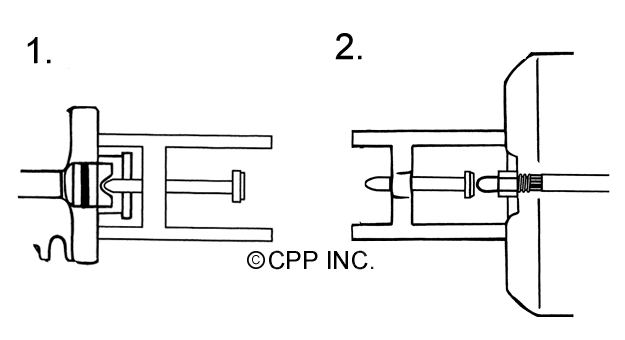
There are basically two different master cylinders that
we use for our Chevy and Ford kits, the Deep Bore master cylinder and the
Shallow Bore master cylinder. To determine which master cylinder your booster
is setup to mate with, you can do the following simple check. For Shallow
Bore master cylinders, the pushrod should be approximately flush with or
below the booster face. Deep Bore master cylinders will protrude past the
face of the booster body by about 1" to 1-1/2". Note that Deep
Bore master cylinders are required for manual brakes and Shallow Bore master
cylinders are generally used for power brake systems. We now supply a master
cylinder piston adapter to accommodate both master cylinders. You will
only use this adapter when you have a Deep Bore master cylinder with a
short booster pushrod.

Back to Top
Check Flexible Brake Hoses
Inspect the flexible brake hoses for typical signs of
fatigue. Hoses should be checked for:
- Worn out hoses: Check for large surface cracks, scuffing
or worn spots. If the outer casing has severe cracks or abrasions, the
hose need to be replaced. The casing is the protection for the hose, if
it is damaged, the deterioration of the hose can take place with possible
burst failure. Lines should be flexible and firm rather than hard and stiff.
- Faulty Installation: Twisting the hose or rubbing against
wheels tires or chassis will cause premature line deterioration.
Make sure that the tube and hose mating surfaces are clean
and free from nicks and burrs. New seal washer(s) should be used. Double
wall steel tubing should always be used to replace hard lines. Care should
be taken when replacing brake tubing, to use the proper bending and flaring
tools and to avoid kinking, routing the tubes against sharp edges, moving
components, in hot areas or above the master cylinder fluid level. All
tubes should be properly attached with appropriate retaining clips and
tabs.
Back to Top
Rear Disc Brakes and Parking Brake
Adjustment
This is another critical item that many people miss when
upgrading to rear disc brakes. Our rear disc brake calipers that are equipped
with an parking brake are self-adjusting. Every time you use the parking
brake they adjusts themselves for pad wear by clicking to the next stop
on the internal ratchet. If you do not use your parking brake during normal
operation of the vehicle, over time the pads will wear and there will be
insufficient contact between the pads and the parking brake mechanisms.
When this happens the parking brake will never engage.
To adjust the parking brake while installing or servicing
the calipers, use the following directions. Failure to adjust the parking
brake can result in no parking brake, brakes dragging, overheating, premature
brake wear or ineffective rear brakes causing excessive front wear and overheating.
- If you are adjusting the parking brake after the system
has been bled, remove the master cylinder lid and make sure that the fluid
level is no more than 1/2 full, this is so that in the following steps
when the caliper piston is pressed back, fluid does not overflow the master.
- With the caliper in place on the wheel, remove the parking
brake spring and lever arm. Remove the seal and nylon washer from the adjusting
screw and place them in a clean location.
- Turn the adjusting screw counterclockwise to tighten
it and collapse the pads until the pads are tight against the rotor.
- Note that the adjusting screw clamps the pads closed
when tightened counterclockwise. When the adjusting screw is turned counterclockwise
past a certain point, it turns the internal ratchet. This is how it is
adjusted. Adjusting the screw can be tricky because when the it is tightened
all the way, its hex head recedes into the caliper body and you can't get
a wrench around it.
- Turn the adjusting screw in counterclockwise by hand
until there is resistance.
- To push the adjusting screw back out to provide access
to it's hex, use two channel-locks to squeeze the rear brake pad and compress
the caliper piston. Place the wrenches on either side of the pad locating
the jaws on the pad bracketry and the body of the caliper.
- Then use a wrench to turn the adjusting screw counterclockwise
to change the position of its hex and slip the internal ratchet.
- Back the adjusting screw out by turning it clockwise,
place the lever arm over the adjusting screw hex and apply a medium amount
of hand force clockwise to the lever arm to push it past the lever stop
on the caliper. Once the force has been applied, the lever should be located
within 1/4" of the lever stop and should be easy to put on the adjusting
screw head. There should also be mild contact between the pads and the
rotor when properly adjusted. It is highly likely that this will need to
be done a number of times before it is properly adjusted.
- Remove the lever arm and replace the nylon bushing and
seal, then replace the lever arm and secure with the nut.
- Replace the return spring and parking brake cable
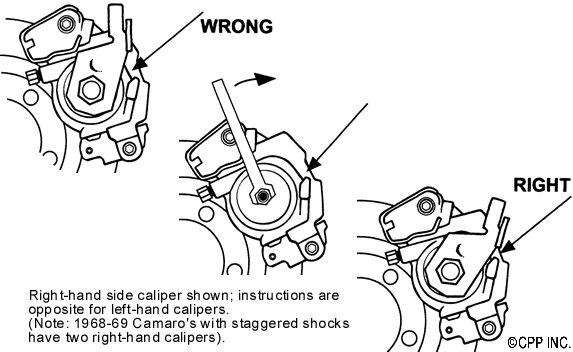 . .
Back to Top
Check Pedal Assembly
Something that many people are not aware of when upgrading
their system is the brake pedal adjustment. Improper pedal adjustment can
do the following:
- Preload the booster causing brakes to drag and eventually
lock up.
- Damage the booster's internal components by actuating
at an improper angle.
- Allow slop in the pedal if adjusted too low.
Many vehicles have a second hole on the pedal assembly
that was originally intended for power brake applications. The required
hole is generally 1" to 1-1/2" lower than the original manual
brake hole. If there is no second hole, you may need to drill the hole
in the pedal arm to properly align the push rod. The easiest way to determine
the perfect location for this hole is to find the center of the push rod's
vertical travel to ensure that its actuation is as inline with the booster
as possible.
- Gently lift the end of the pushrod until it stops and
noting the location where the clevis on the pushrod locates on the pedal
arm. You can mark this location.
- Then gently push the pushrod down until it stops. Mark
this location as well.
- The proper hole location is in the middle between the
two marks on the pedal arm. Mark and drill the new hole in the center of
the pedal arm. Attach the pushrod to the pedal arm.
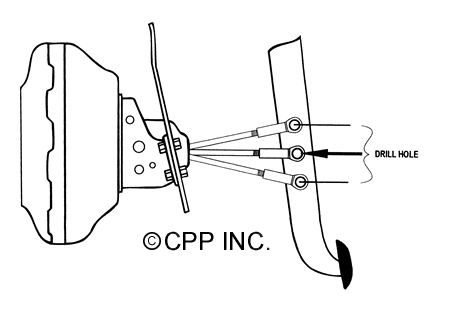
- Check freeplay in the pedal by applying pressure to the
pedal with your hand and noting how far the pedal travels before resistance
is felt. It should be approximately 1/4". This freeplay allows the
master cylinder piston to return to the "at-rest" position and
prevents preloading the system. Too much freeplay will drop the pedal too
far before applying brake pressure and may even hit the floor before applying
full braking force to the system. Note freeplay is also dependent upon
proper adjustment of the booster pushrod. See "Check the Booster Pushrod"
below.)
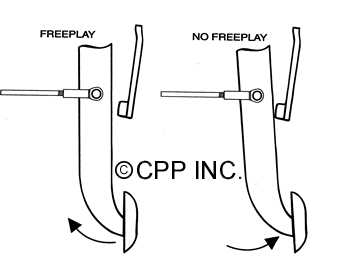
Back to Top
Check Proper Caliper Alignment
The proper alignment of the calipers is critical to a
safe brake system and preventing premature wear on the rotors and pads.
It may be necessary to grind small protrusions on the caliper to ensure
a proper fit and alignment of the calipers on the caliper brackets. DO
NOT grind on the caliper brackets, this will weaken the design of the
brackets and may lead to brake failure. Be aware that grinding can produce
a tremendous amount of heat. Because of the relatively thin amount of material
of the plate, subjecting the brackets to this heat may causing them to
become brittle and break under stress!
If wheel flange is warped causing the caliper and bracket
to not align properly with the rotor as in the figure below on the left,
insert one or two washers between the wheel flange and the caliper bracket.
Use the washers to shim the assembly and align with the rotor as necessary.
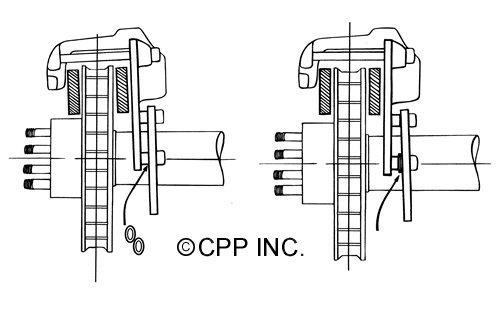
Back to Top
Test Master Cylinder
Note that this test of the master cylinder requires a
complete re-bleeding of the system since the brake lines are removed from
the master to perform this test. This is why we include this test during
the bench bleeding process. However, just because you have performed
the test during bench bleeding does not mean that that air has not entered
the master cylinder since then. Should air enter the master cylinder
at any time after bench bleeding, the master cylinder MUST be removed
from the vehicle and bench bled again. A number of things can cause air
to enter the master cylinder:
- If the fluid levels drop too low during the bleeding
process.
- If the master cylinder was left sitting for too long
after the bench bleeding before having the lines installed.
- Mishandling of the master cylinder such as if it were
dropped or jarred excessively.

- Remove the brake lines from the master cylinder ports.
- Block off the master cylinder brake line ports using
the correct size inverted flare plugs or bolts with the appropriate thread
size for the ports on your master cylinder. Dual port master cylinders
that have ports on both sides need to have all four ports plugged. The
protruding cone of the inverted flare seat in the master cylinder port
is made of a soft material that can easily be deformed if over tightened.
If using bolts, be sure to just snug the bolts so as not to damage the
cone seal surface. This cone mates with the inverted flare (expanded mouth
opening) of the brake lines. If you have the ability, you can also drill
a point into the end of the bolt to help prevent this from occurring. Most
GM master cylinders use 9/16-18 threads for the front ports and 1/2-20
threads for the rear ports. Most Ford master cylinders use 3/8-24 threads
for the front ports and 7/16-24 threads for the rear ports.
- Apply constant pressure to the pedal, the pedal should
be firm, hard and should not drop over time.
- If the pedal is squishy there may be air in the master
cylinder. Bench bleed the master according to the instructions above and
test again.
- If the pedal is firm and then drops over time under constant
pressure, the master cylinder should be replaced.
Back to Top
Test Combination/Proportioning
Valve
- Use a test light by attaching a clip to a positive contact
on the vehicle and touch the point of the tester to the electrical connection
of the combination valve. If the the light does not come on, the valve
system is operating correctly and no further testing is required.
- If the light does come on, this indicates that the pressure
differential valve is stuck in the front or rear position.
- Bleed the brake system to determine if the front or rear
lines are blocked off. Set up one front wheel and one rear wheel for bleeding
at the same time. Crack both bleeder screws and gently pump the pedal a
few times.
- The blocked side will trickle fluid out when the bleeder
screw is cracked and the pedal pressed. An unblocked line will squirt fluid
out the bleeder.
- The lines that are clear must be left open and the blocked
lines should have the bleeder screws tight to cause pressure to build up
on that side. Be sure to use the standard bleeding procedures to prevent
air from entering the system.
- Slowly press the pedal with steady pressure a number
of times until the light goes out; this will center the differential valve.
You may also hear a pop come from the proportioning valve. This is the
metering valve returning to its equalized position. When the light goes
out, close the bleeder screw. (See fig. below)
.gif)
Back to Top
Test Power Brake Booster
If the pedal feels "hard" while the engine is
running, the booster isn't operating correctly. If you suspect the booster
is defective, do not attempt to disassemble or repair the power booster.
Doing so is unsafe and will void your warranty.
Test 1
- With the engine off, pump the brake pedal to remove any
residual vacuum in the booster.
- Hold pressure on the pedal while you start the engine.
When the engine starts, the pedal should drop about a 1/4", this indicates
that the booster is working properly.
Test 2
- Run the engine a couple of minutes.
- Turn the engine off and press the pedal several times
slowly. The first pump should be fairly low. The second and third should
become slightly firmer. This indicates an airtight booster.
Test 3
- Start the engine and press the brake pedal, then stop
the engine with the pedal still pressed. If the pedal does not drop after
holding the pressure on the pedal for 30 seconds, the booster is airtight.
Inspect the Check Valve
- Disconnect the vacuum hose where it connects to the intake
manifold. Do not disconnect the vacuum line from the booster. Air should
not flow when pressure is applied, but should flow when suction is applied.
If air flows in both directions or there is no air flow, the valve needs
to be replaced.
Verify Enough Vacuum
- Check the operating vacuum pressure when the engine is
at normal operating temperature. There should be a minimum of 18 in. of
vacuum. Vacuum may be increased by properly tuning the engine, checking
for vacuum leaks and blockages in vacuum lines.
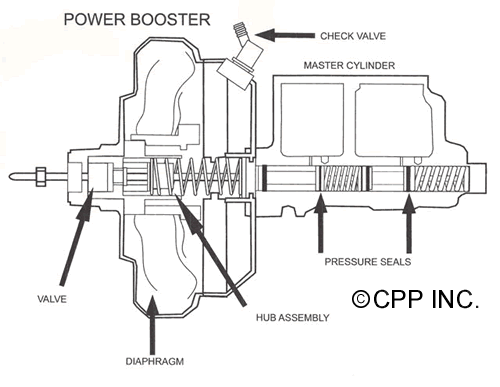
Back to Top
Brake Fade
Brake fade is a gradual loss of braking power that can
be caused by old brake fluid or overheated brakes. Overheated brakes is
a very dangerous situation which can cause old or contaminated brake fluid
to boil. The gasses released from boiling brake fluid will cause a squishy
pedal even after the brakes have cooled and can cause brake failure if
not immediately taken care of. This is all the more reason to ONLY use
brake fluid that is from a newly opened sealed container. Drum brakes
can compound the problem of overheated brakes. Since the drum itself expands
when heated, it increases the amount of travel required by the shoes to
effectively stop the vehicle. Brake fade can also occur in drum brakes
by the accumulation of water inside the drum since it traps water inside.
The water then acts as a lubricant between the shoes and the drum, causing
ineffective braking.
Back to Top
Why change to Disc Brakes?
- Disc brakes offer a significant advantage over drum brakes
in a number of areas, the most important is in safety.
- Disc brakes resist heat induced brake fade. The design
of disc brakes dissipates heat much more quickly than drum brakes. Also,
heat causes the disc to expand which has no effect on braking ability where
as the drum expands it increases the amount of travel required for the
shoes to apply effective stopping force.
- Disc brakes resist water induced brake fade. When disc
brakes become wet, the large majority of the water is spun off of the disc
during rotation. The residual water evaporates from the heat caused during
braking. In a drum brake set up, water can become trapped inside the drum
and act as a lubricant between the drum and shoes causing water induced
brake fade.
- Disc brakes are better at straight-line stops. Drum brakes
have a tendency to pull due to inconsistent alignment of the shoes from
the left to right wheels due to a dependency on multiple complex floating
mechanisms. These inconsistencies can cause the car to veer unexpectedly
to one side or the other during panic braking. Since disc brakes apply
equal force through clamping, they are much safer during straight line
braking.
- Ease of serviceability. Disc brakes are much easier to
service than drum brakes.
- Lighter weight
- Recommend the addition of a power brake booster for disc
brakes.
|